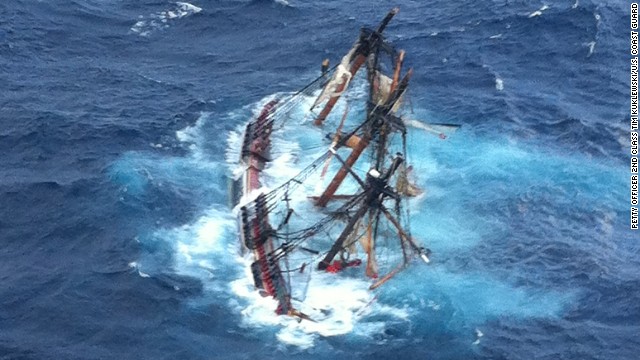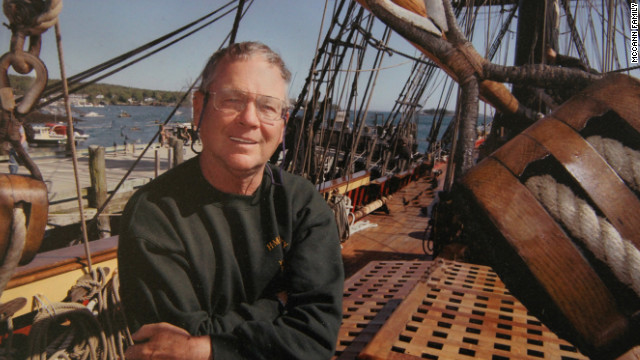First federal report on Bounty sinking blames captain
February 10, 2014 -- Updated 2213 GMT (0613 HKT)
Sailors in the tall ship community have criticized Walbridge's decision to leave safe harbor in New London, Connecticut, on a voyage to Florida while Hurricane Sandy approached.
Bounty Capt. Robin Walbridge's "reckless decision to sail ... into the well-forecast path of Hurricane Sandy" was the probable cause of the tall ship's October 2012 sinking off the coast of North Carolina, the National Transportation Safety Board said in a report released Monday.
The ship, carrying 16 crew members, flipped sideways in heavy seas and high winds, spilling everyone into the Atlantic.
.
.
Walbridge, 63, was never
found and is presumed dead; deckhand Claudene Christian -- a 42-year-old
rookie -- died after Coast Guard rescuers were unable to revive her.
The NTSB report -- and a
similar investigation report expected to be released by the Coast Guard
-- could lead to changes in rules governing how attraction vessels like
the Bounty are inspected for safety.
.
.
Before the ship left port
in New London, Connecticut, for St. Petersburg, Florida, the captain
indicated he knew the hurricane was moving up the Eastern Seaboard,
according to crew testimony at Coast Guard hearings in 2013.
.
.
Heading into the storm's
path "subjected the aging vessel and the inexperienced crew to
conditions from which the vessel could not recover," Monday's NTSB
report said. Ten of Bounty's crew members had been aboard for less than a
year -- including two who had joined less than a month before the
sinking.
.
.
"The Bounty's crew was
put into an extraordinarily hazardous situation through decisions that
by any measure didn't prioritize safety," NTSB Chairman Deborah Hersman said in a statement.
The report said it's
"possible that the captain may have focused too narrowly on the position
of the storm's eye instead of on Sandy's total expanse." The storm was
huge, spanning more than 1,000 miles in diameter. The "area into which
the Bounty was heading was already under tropical storm warnings, with
conditions forecasted to worsen," the report said. "Still the captain
seemed to believe that he could outrace the storm."
.
.
By the time the captain
and crew realized the ship was sinking, the Bounty was tossing in
30-foot seas and being battered by 103 mph winds about 100 miles off
Cape Hatteras.
During the Coast Guard
hearings 14 surviving crew members testified. Not one leveled any blame
for the disaster at their shipmates or at Walbridge.
Bounty deckhand Claudene Christian, didn't survive the shipwreck. Before she began working on the ship in May 2012, Christian had virtually no tall ship experience and had never before sailed in a hurricane. Christian's parents are attending Coast Guard fact-finding hearings about the disaster. ...
Bounty deckhand Claudene Christian, didn't survive the shipwreck. Before she began working on the ship in May 2012, Christian had virtually no tall ship experience and had never before sailed in a hurricane. Christian's parents are attending Coast Guard fact-finding hearings about the disaster. ...
On Monday, Bounty survivor Jessica Hewitt told CNN on the phone that some of the report's nuances rubbed her the wrong way.
She said the report
mistakenly paints the captain as disregarding the crew's well being.
.
"Robin thought a lot about safety," Hewitt said. "But I agree that he also during his career had been walking this line of going out in big storms and making it." They made it through the storms, despite Bounty's less-than-perfect condition, Hewitt said, because Walbridge "was good -- and the crew was good. That boat lasted so long because he was so good."
.
"Robin thought a lot about safety," Hewitt said. "But I agree that he also during his career had been walking this line of going out in big storms and making it." They made it through the storms, despite Bounty's less-than-perfect condition, Hewitt said, because Walbridge "was good -- and the crew was good. That boat lasted so long because he was so good."
The Bounty was arguably
the world's most famous traditionally rigged replica ship. The
three-masted square rigger appeared in several Hollywood films,
including the "Pirates of the Caribbean" franchise.
At Coast Guard hearings,
crew members testified that the Bounty suffered from a reputation in
the tall-ship community for shoddy maintenance and spotty training.
.
.
"Contributing to the sinking was the lack of effective safety oversight by the vessel organization," Monday's report said.
The report stated that,
although the Bounty took on water even in good conditions and wood rot
had been discovered, the captain gave no order to ensure all onboard
pumps were fully operational before departing. This, despite his
knowledge that the ship was sure to encounter rough seas as it sailed
closer to Sandy, according to the report.
.
.
Robert Hansen, a
representative of the ship owner HMS Bounty Organization, LLC, e-mailed
CNN: "I am unable to comment on the report (which we have not seen) or
the pending litigation."
For decades before the
sinking, the Bounty sailed as an attraction vessel — moving from port to
port and charging tourists admission to board it while it was docked.
.
.
To charge admission for
shipboard tours at dockside, the Bounty required only a simple, brief
Coast Guard inspection that checked for obvious safety issues such as
major leaks or malfunctioning emergency equipment. The Bounty passed one
of these about two months before the disaster.
.
.
Christian's family has
filed a civil lawsuit against the ship's owner. The case is currently in
settlement talks. Christian's parents are "not doing well at all," the
family's attorney Ralph Mellusi told CNN. "We now have one report — and
when the next one comes down, that will help put some closure on this
for them."




No comments:
Post a Comment